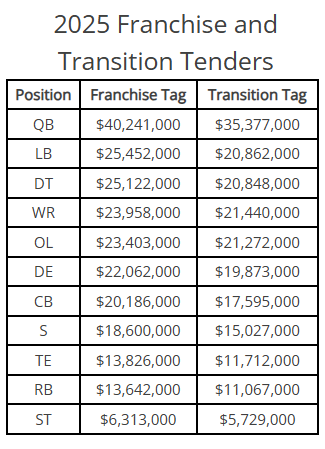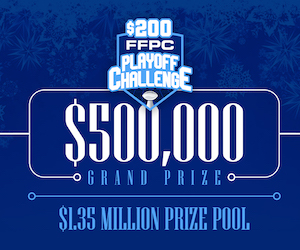What is the difference between Franchise Tag Vs. Transition Tag in NFL Free Agency? Definiton and meaning of Franchise Tag and Transition Tag for Fantasy Football.
The Philadelphia Eagles have stopped the Kansas City Chiefs from becoming the first team to ever three-peat as Super Bowl champions. It turned out, much to the chagrin of Giants fans, myself included, that Saquon Barkley was the missing piece to their championship. But just like A.J. Brown has done, it is time to start looking ahead to 2025 and who will be crowned the next Super Bowl champions of the National Football League. That journey begins on March 12 with the start of the official league year and the beginning of free agency. The concept of free agency is rather simple: unsigned players can sign with new teams for more money. Players get paid for their performance, and teams can improve by adding talent to the depleted positions on their roster. However, the process of free agency is intricate and quite complex, but fear not, I am here to break it all down for you in my Free Agency series that covers the difference between franchise tagged and transition tagged players, unrestricted and restricted free agents, and the Legal Tampering Period.
Players become free agents for a variety of different reasons. Some players’ contracts are expiring, some players are cut from their teams, and some players can only be signed to contracts with new teams under certain conditions. Furthermore, there are two designations of free agents: restricted and unrestricted free agents. Perhaps the most complex aspect of free agency is the variety of ways that teams can protect themselves from losing a valuable player. Teams can apply the franchise tag or transition tag and a first, second, or Right-Of-First-Refusal tender, depending on their free-agent status. Now, let's dive in so you can follow along when free agency kicks off and breaking news starts dropping every hour. It is one of the best times of the year, and I can’t wait to see the madness that ensues.
In this article of the Free Agency series, let’s discuss the franchise tag versus the transition tag. When it comes to players with four or more accrued seasons, NFL teams have two options to prevent their superstar players from becoming unrestricted free agents and signing with another team when their contracts are about to expire. The first option is the franchise tag, which can be exclusive or non-exclusive, and the second option is the transition tag.
Holiday Special! Save 50% on any Premium Pass using discount code THANKS. Win more with our DFS, Betting and Season-Long Pass, get expert tools and advice from proven winners! GAIN ACCESS
Franchise Tag
A franchise tag is essentially a one-year contract. The NFL predetermines the salary for players who play under the franchise tag based on their position. Teams have until 4:00 PM on March 4, 2025, to place a franchise tag or transition tag on one of their players, and the player must either sign the tag and play for that salary or negotiate a long-term deal with his team before July 15, 2025.
The salary for a franchise-tagged player is set in one of two ways: either by averaging the top-5 salaries by position for the previous league year, or if it’s higher, 120% of a player’s salary from the previous season. This means players like quarterbacks and defensive ends will have a significantly higher salary under the franchise tag than positions like tight end or running back.
Teams can franchise tag a player up to three times if a long-term deal cannot be reached; however, subsequent franchise tags result in a significant increase in salary for the player. The second franchise tag on a player requires a 120% increase from the player's salary under the initial franchise tag.
However, if a team wants to franchise tag a player three years in a row, the player’s salary is either an increase of 144% from the second franchise-tag salary or an average of the top five salaries at the highest-paid position, whichever is higher. Take a second and read that again. The average of the top five salaries at the highest‑paid position, not the same position. This means that if a team wanted to franchise tag a tight end for three years straight, his third year under the tag would pay him the one-year salary of a franchise-tagged quarterback. That is why you never see a player tagged three years in a row.
The last thing to note about the franchise tag and transition tag is that a team can only use one each season, not both. If an NFL team franchise tags their quarterback, they cannot use the transition tag on another player and vice versa.
Exclusive Tag vs. Non-Exclusive Tag
When it comes to placing the franchise tag on a player, the tag can be either exclusive or non-exclusive. An exclusive franchise tag is equivalent to putting the player in jail. He is not allowed to negotiate with any other teams and must either sign a long-term deal by July 15, 2025, or play under the franchise tag for one year and accept the predetermined salary. This usually results in the player holding out from training camp and preseason in hopes of a getting a new multi-year deal.
If the July 15 deadline passes without the team and player reaching a long-term deal, the only other option is for both sides to agree to a one-year deal similar to the franchise tag, however, this allows players to negotiate a signing bonus and some incentives into their one-year contract, something they cannot do under the franchise tag. This played out most recently with Barkley on the New York Giants and Josh Jacobs on the Las Vegas Raiders.
The Giants and Raiders both chose to franchise tag their stud running backs rather than sign them to a long-term deal. Both Barkley and Jacobs held out beyond the July 15 deadline but ultimately agreed to a re-worked one-year contract to remain with their teams. Rather than sign the $10.1M franchise tag, Barkley and the Giants agreed to a one-year deal for $11M, with $2M being paid immediately as a signing bonus.
His salary was the same as the franchise tag at $10.1M, but by not signing the tag and agreeing to the re-worked deal, he was able to add $900,000 in incentives and get $2M upfront. Jacobs signed a similar deal with a little more in incentives than Barkley and both players played their final season for the teams that drafted them.
Contrary to the exclusive tag, the non-exclusive franchise tag allows the player to negotiate with other teams for a potential long-term deal, hence, non-exclusive. However, the original team is still protected from losing the player by giving it a Right of First Refusal, similar to restricted free agents (discussed further in the next article in this series), but with much more significant compensation if they lose the player. If another team reaches an agreement with the non-exclusive franchise-tagged player, they must sign that player to an offer sheet that lays out the full terms of the proposed contract.
The Right of First Refusal gives the original team the right to match any offer made to the franchise-tagged player. If the team matches the offer, then it creates a contract with the franchise-tagged player. If the team does not match the offer, then the player signs with the new team, but the original team receives two (2) first-round picks as compensation for losing the player. You will rarely see an offer sheet signed for a player with the non-exclusive franchise tag because teams are very reluctant to give up two first-round picks for any player who is not a franchise quarterback.
Fortunately for us fans of the complexities of the NFL rules and regulations, we got to see this exact situation play out last year. Baltimore Ravens quarterback Lamar Jackson wanted a long-term deal that fully guaranteed him close to $200 million, but the Ravens did not want to guarantee that much. Confident that no other team would want to guarantee that much money to Jackson and give up two first-round picks to the Ravens, the team gambled and placed the non-exclusive franchise tag on Jackson, allowing him to negotiate with other teams.
There was no downside for the Ravens as they could match any offer that Jackson agreed to, and if the offer was too steep, the team would receive two first-round draft picks in return. It also allowed time to show Jackson, as the Ravens had hoped, that other teams were unwilling to guarantee the amount of money he wanted, which would essentially prove his actual market to him.
Well, lo and behold, it worked out exactly as the Ravens had hoped, and no other team even attempted to negotiate with Jackson, at least not publicly. In hindsight, a few teams should have made an offer considering the two league MVPs he has won since (it should have been three).
This season, the most notable name to be tagged is Cincinnati Bengals wide receiver Tee Higgins. This will be the second time that the Bengals have opted to place the non-exclusive franchise tag on Higgins, so his salary for this season if he is not signed to a long-term deal by July 15th is $26,179,200, which is 120% of his salary last year on the tag ($21,816,000), and approximately 9% more than the 2025 salary for a franchise-tagged wide receiver.
Note: The team signing the non-exclusive franchise-tagged player to an offer sheet must have a first-round pick in both of the next two upcoming drafts to be eligible to negotiate with that player. The Miami Dolphins and the San Francisco 49ers were, therefore, ineligible to negotiate with Jackson because they did not have a pick in the first round of both drafts.
Transition Tag
The second option an NFL team has to protect their superstar player from leaving is the transition tag. The transition tag is essentially a poor man’s non-exclusive franchise tag, and the salaries are comprised of the average of the top 10 players at their respective positions, which results in lower salaries than those under the franchise tag. The transition-tagged player also has the right to negotiate with other teams, and if another team signs the player to an offer sheet, the original team still has a Right of First Refusal to match the offer.
The difference, however, is that if the original team does not match the offer, the player signs with the new team, but the original team receives zero compensation in return. So why would a team use the transition tag instead of the non-exclusive franchise tag?
First, the predetermined salary for a transition-tagged player is significantly less than that of a franchise-tagged player. Second, the transition tag allows teams to test the market for a given player because prospective teams usually will not sign a non-exclusive franchise-tagged player to an offer sheet, given the two first-round picks they will have to give up if they do so (i.e., the Lamar Jackson situation).
If another team knows it doesn't have to give up anything in order to sign the transition-tagged player, they are much more likely to make an offer, which gives the original team a very good idea on the player’s market without making him available or negotiating trades.
Despite this, there was a drastic decrease in the use of transition tags until 2011 because, prior to that, prospective NFL teams started adding language to their offer sheets that basically made it a guarantee that the original team would not or could not match the offer. These terms were known as “poison pills” in an offer sheet.
The best example of a poison pill happened in 2005 when the Seattle Seahawks placed the transition tag on offensive guard Steve Hutchinson. The Minnesota Vikings signed Hutchinson to an offer sheet for $49 million with $16 million guaranteed, but they included language that said the entire $49 million contract was fully guaranteed if Hutchinson were not the highest-paid offensive lineman on the team he signed with. He would have been the highest-paid offensive lineman on the Vikings, but he would have been the second-highest-paid offensive lineman on the Seahawks.
This offer sheet basically meant that if the Seahawks wanted to match the offer, Hutchinson’s $49 million was fully guaranteed. The Seahawks challenged the language in binding arbitration pursuant to the collective bargaining agreement (CBA) and lost. As a result, they did not match the offer sheet, and the Vikings signed Hutchinson without having to give anything up in compensation to the Seahawks. Poison pill clauses have thankfully been banned since the 2011 CBA due to the inherently unfair position teams were placed in by savvy lawyering.
2025 NFL salary cap: $279.2M
2025 Franchise/Transition Tag Salaries:
Download Our Free News & Alerts Mobile App
Like what you see? Download our updated fantasy football app for iPhone and Android with 24x7 player news, injury alerts, rankings, starts/sits & more. All free!

More Fantasy Football Analysis





 RADIO
RADIO
























